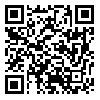Volume 4, Issue 4 (December 2022)
IEEPJ 2022, 4(4): 243-251 |
Back to browse issues page
Download citation:
BibTeX | RIS | EndNote | Medlars | ProCite | Reference Manager | RefWorks
Send citation to:



BibTeX | RIS | EndNote | Medlars | ProCite | Reference Manager | RefWorks
Send citation to:
Marzoghi R, Hasanzadeh S, Jahani J, Torkzadeh J. (2022). Analysis of Internal, External and Institutional Structure in the Effectiveness of Tourism Education Courses: A study Based on Confirmatory Factor Analysis. IEEPJ. 4(4), 243-251. doi:10.52547/ieepj.4.4.243
URL: http://ieepj.hormozgan.ac.ir/article-1-499-en.html
URL: http://ieepj.hormozgan.ac.ir/article-1-499-en.html
1- Professor, Management and Educational Planning Department. Faculty of Education and Psychology, Shiraz University, Shiraz, Iran
2- Phd Student of Curriculum, Faculty of Education and Psychology, Shiraz University, Shiraz, Iran , shahram_h89@yahoo.com
3- Associate Professor, Management and Educational Planning Department. Faculty of Education and Psychology, Shiraz University, Shiraz, Iran
2- Phd Student of Curriculum, Faculty of Education and Psychology, Shiraz University, Shiraz, Iran , shahram_h89@yahoo.com
3- Associate Professor, Management and Educational Planning Department. Faculty of Education and Psychology, Shiraz University, Shiraz, Iran
Abstract: (948 Views)
The overall purpose of this study was to analyze the factor structure of the scale of effectiveness of tourism education courses. The research method is descriptive methodology. The statistical population of the study included all participants in tourism education projects who were selected as a sample using simple random sampling based on Cochran's formula of 223 people. A researcher-made tool was designed based on a three-dimensional model of internal, external and institutional effectiveness. The scale consisted of 3 subscales and 27 items from the Likert five-choice range. In order to measure the validity of the scale, two methods of item analysis and confirmation factor analysis of the first and second order and to measure its reliability, Cronbach's alpha method was used, which showed the desired validity and reliability of the instrument. The results of item analysis indicated a significant correlation between each item and the corresponding dimension subscale. The result of the first and second order confirmatory factor analysis also showed that each item has a high validity to explain the relevant dimension and to explain the effectiveness of tourism training courses. Also, based on Cronbach's alpha values, the reliability of the scale and related subscales has been evaluated as desirable. Based on the findings of this study, it indicates that this scale can be used to measure the effectiveness of tourism education courses in internal, external and institutional dimensions. Therefore, planners and officials can use it to determine the effectiveness of tourism training courses.
Type of Study: Original |
Subject:
Educational Psychology
Received: 2022/03/17 | Accepted: 2022/07/26 | Published: 2022/11/1
Received: 2022/03/17 | Accepted: 2022/07/26 | Published: 2022/11/1
References
1. Airey, D., & Tribe, J. (2006). An international handbook of tourism education. Routledge. [DOI:10.4324/9780080458687]
2. Ebrahimi, M., & Hasami, S. K. (2014). Standardization, educational effectiveness and comparative comparison of evaluation models by presenting a comprehensive evaluation model. Standard and Quality Management, 5(4), 50-56.
3. Hosseini , S. S. (2016). Evaluating the Training Condition of Tour Guides in Iran Focusing the Proposal of an Educational Model at University Level. Tourism Management Studies, 9(28), 115-144.
4. Ishmael-Robertson, C. A. (2018). What are the key advances in human resource development that tourism in Guyana needs by 2025? Worldwide Hospitality and Tourism Themes, 10(5), 605-610. [DOI:10.1108/WHATT-05-2018-0034]
5. Kirkpatrick, D., & Kirkpatrick, J. (2006). Evaluating training programs: The four levels. Berrett-Koehler Publishers.
6. Laing, J. (2018). Festival and event tourism research: Current and future perspectives. Tourism Management Perspectives, 25, 165-168. [DOI:10.1016/j.tmp.2017.11.024]
7. Naqibzadeh, M. (1997). A look at the philosophy of education. Tahori Publications.
8. Salas, E., Tannenbaum, S. I., Kraiger, K., & Smith-Jentsch, K. A. (2012). The science of training and development in organizations: What matters in practice. Psychological science in the public interest, 13(2), 74-101. [DOI:10.1177/1529100612436661]
9. Santa-Cruz, F. G., & López-Guzmán, T. (2017). Culture, tourism and world heritage sites. Tourism Management Perspectives, 24, 111-116. [DOI:10.1016/j.tmp.2017.08.004]
10. Tomlinson, S. (2005). Education in a post-welfare society. McGraw-Hill Education (UK).
11. TorkZadeh, J., & Keshavarzi, F. (2016). The Effectiveness of Medical Education Curriculum: Internal, External and Institutional. Educational Development of Judishapur, 7(1), 10-21. https://edj.ajums.ac.ir/article_89510_561813a8bce1af8845daff73e405ede9.pdf
12. van der Merwe, C. D. (2016). Tourist guides' perceptions of cultural heritage tourism in South Africa. Bulletin of Geography. Socio-economic Series(34), 117-130. [DOI:10.1515/bog-2016-0039]
Send email to the article author
| Rights and permissions | |
 |
This work is licensed under a Creative Commons Attribution-NonCommercial 4.0 International License. |









